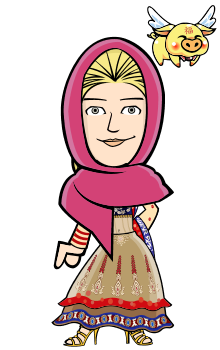Parts of Plants
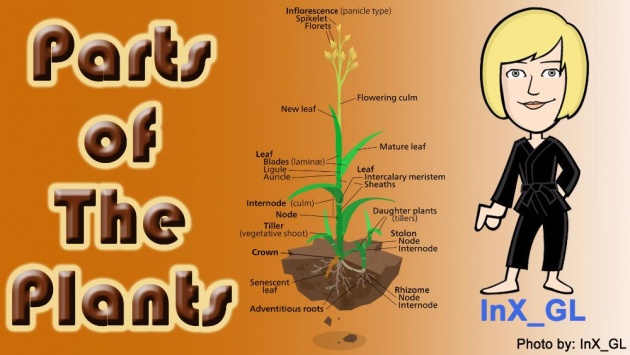
Photo Credit: InX_GL via bitLanders
Plants have a special significance in our lives. Plants produce oxygen for us to breathe. Plants exhale the oxygen during the photosynthesis procedure.
There are five main parts of a plant.
1- Roots
2- Stem
3- Leaf
4- Flower
5- Fruits
1- Roots:
Roots perform two main functions
Do you know what the minerals are?
A natural material that forms from non-living matter in the Earth called Minerals. Plants absorb minerals from the soil.
Roots go down into the soil and spread out to hold the plant firmly. The roots have many tiny hairs called root hairs. These hairs absorb water and minerals from the soil.

Photo Credit: Timon Singh Via inhabitat
Roots hold the plant in the ground and take in water from the soil. Roots spread like a cluster in the ground to strengthen the hold. The scientists have divided them into 14 species.
- Adventitious roots
- Aerating roots
- Aerial roots
- Contractile roots
- Coarse roots
- Fine roots
- Haustorial roots
- Propagative roots
- Proteoid roots
- Stilt roots
- Storage roots
- Structural roots
- Surface roots
- Tuberous roots.
Some of the roots of plants are such that we can eat, such as carrots, radishes, turnips, and potatoes.
2- Stem:
The stem joins the roots to the rest of the plant. A stem also carries food prepared by the leaves to other parts of the plant. There are many tiny tubes inside the stem. Water and minerals from the roots move to leaves through these tubes. Basically, the stem is a bridge between plant and the roots.

Photo Credit: Garden Weasel
Potatoes grow underground that’s why we call them underground stems.
When the roots are absorb water and minerals from the soil they reach to the leaves of plants through stems. These components are delivered to leaves through the micro and small tubes in the stem.

Photo Credit: Encyclopedia Britannica, Inc
The leaves use these ingredients to produce food for the plant. Some of the stem that grows under the ground we use as food such as carrot and potatoes etc. It also works like those stems that are above the ground. The stem and the roots are the basis of a plant. The roots strengthen to the plant under the ground and stem strengthen to the plant above the ground.
So the both roots and stem are the part of the plants which strengthen to the plant and help the plant to grow up.
3- Leaf:
The third main part of the plant is the Leaf.
Structure of a Leaf;
Video Credit: Flexiguru Via YouTube
There are four parts of the leaf.
- Side Veins & Mid Veins
- Stalk
- Stomata
Side Veins & Mid Veins:
The absorbed materials and food move in the leaf and plant by these veins. Both mid and side veins circulate the minerals to the leaf to produce the food and circulate the prepared food to the plant.
Stalk:
Leaf stalk joins the leaf to the branch. It is a connection between leaf and plant. The side veins and mid veins joint by the stalk to plant, to move the food from leaf to plant, and minerals from plant’s root to the leaf.
Stomata: (Plural of Stoma)
The lower side of the leaf bears many tiny holes. These holes are called stomata. A leaf takes in carbon dioxide from the air through stomata. Leaves make food for the plant. To prepare food, a leaf needs sunlight, water, and carbon dioxide. This process is called photosynthesis. Green coloring matter in leaves is called chlorophyll. Chlorophyll absorbs light from the sun to make food. During this process, plants give off oxygen, which is necessary for us to breath.
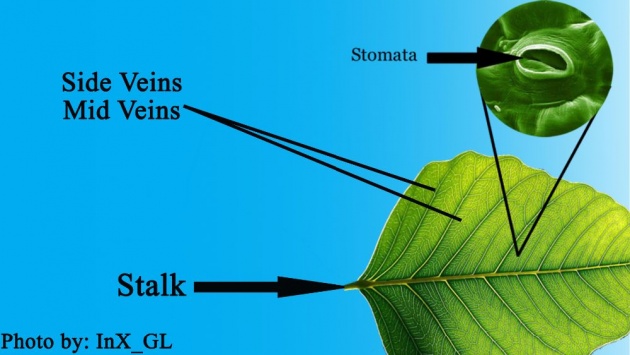
Photo Credit: InX_GL via bitLanders
We inhale oxygen in the breathing process and remove carbon dioxide. The plants take in carbon dioxide to make food and oxygen are excluded.
4- Flowers:
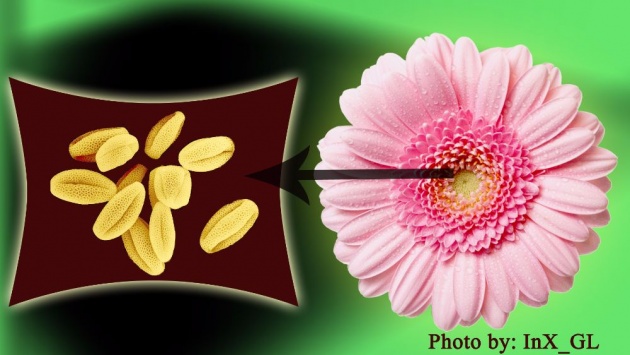
Photo Credit: InX_GL via bitLanders
Many plants bear flowers. The main function of the flowers is to make seeds. Inside a flower is a sticky powder called pollen or pollen grains. Pollen grains help flowers to make seeds. Insects visit flowers and help to move the pollen grains.
The one side of the follower makes pollen grains. Another part of the flower uses these grains to make seeds. The seeds can grow into new plants.
How do plants make seeds?
Wind and water can move pollen grains. Animals, such as bees and birds can also move pollen grains from one flower to the other.
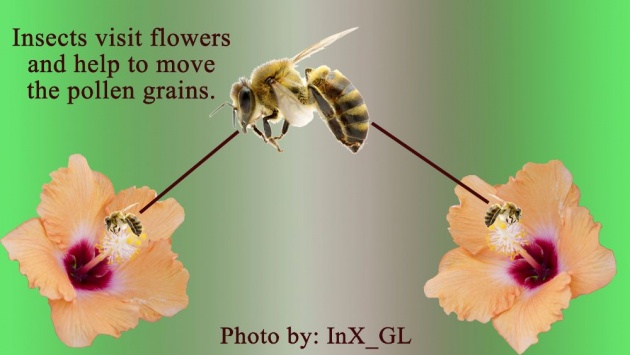
Photo Credit: InX_GL via bitLanders
Deep inside a flower, nectar is present. The good smell of the flowers attracts bees, butterflies, and hummingbirds. As they get the nectar, pollen grains stick to their bodies. They carry these grains to another flower.
How do seeds move?
Wind and water can carry seeds far away. Animals also help to move seeds to new places. For example, a parrot eats a fruit, including the seeds, and flies away to another place to sit. Now when he will stools, "because parrots cannot digest seeds", so, the seed moves to the new place through his stool.
Another example is, the same method of stool also applies with the sheep but the other one is the sheep’s fur, they carry seeds on their furs.
The third method is the wind can carry maple tree seeds to new places. Because they have very light weight so the wind can easily fly them.
How do seeds move and form new plants?
Video Credit: UrbanMali via YouTube
How do seeds grow?
We hide seeds in the soil and water them. The seeds grow into new plants. The seeds absorb water and burst from the soil. After few days the roots come out first and move downward now the roots will absorb the minerals from the soil. After a few more days the shoot comes out and bears leaves.
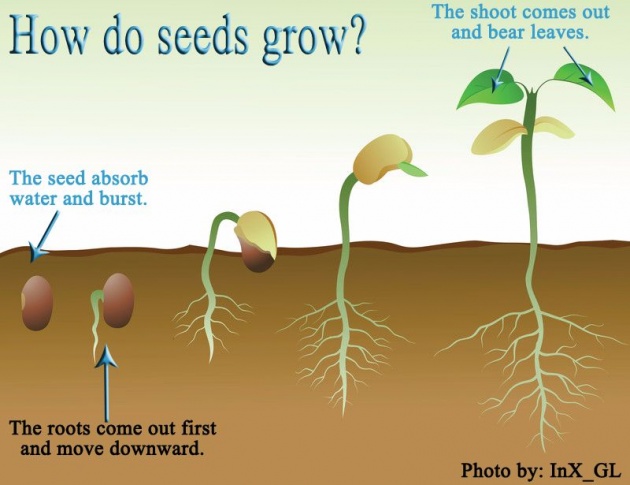
Photo Credit: InX_GL via bitLanders
5- Fruit:
Formation of Fruit:-
Plants that have flowers make fruit. After the transfer of pollen grains the part of flower grows bigger and bigger to become fruit. The fruit contains seeds. The seeds can grow into new plants. Like roots, few seeds we used to eat, like, pomegranate fruit. The flower of pomegranate grows bigger and become (Anarkali) after that it grows bigger and turns into pomegranate fruit. We eat pomegranate seeds; the seeds are red, which is full of juice.

Photo Credit: InX_GL via bitLanders
The fruits protect the seeds inside. Some fruits have single seed some have two or several seeds. The Mango, peach, plum has single seed. Lemon, Guava, pears, and pomegranate have few or may be several seeds.
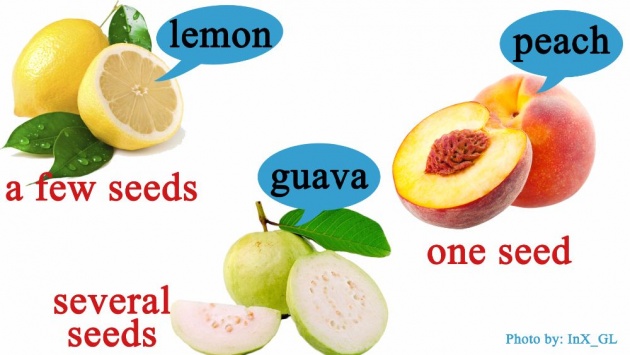
Photo Credit: InX_GL via bitLanders
So here is the end of my blog, for the past few days, I have been selected topics for blogs, which have become the real needs of our society. Like, Animals, Plants etc. These are items without which we cannot imagine our lives. Animals provide us milk and meat to eat and help us in our daily routine works. I have described in detail in my previous blog about it. Similarly, the plants are also necessary for us. We cannot inhale oxygen without them, as I have already expanded about it that they give off oxygen during their food making process (Photosynthesis).
So the conclusion of my blog is;
Please save both Animals and Plants. Thanks for reading. I am thinking about my next blog, I thought the Topic should be the Water. I’ll try to write something about “water” in my next blog. Stay connected fellow.
Till then
“TA TA, Bye Bye”
I am very excited to get the results of this blog, I am expecting 5 stars on this blog, as I have tried my best to fulfill all the requirements, Let's see what will be the results. :-( or :-) :-|
All right Reserved InX_GL (biltnaders user) 07-06-2017

